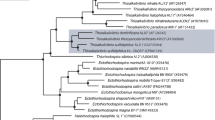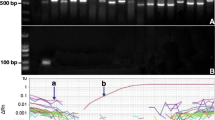Abstract
Geosmin, produced by cyanobacteria and actinomycetes, is a common cause of earthy odor in lakes, rivers, and reservoirs. Drinking water quality standards in Japan requires that geosmin concentration be maintained at < 10 ng/L. The concentration of musty/earthy odor compounds in water bodies tends to exhibit a positive correlation with the cell density of cyanobacteria producing these compounds. In general, it is difficult to accurately distinguish and quantify musty/earthy odor-producing cyanobacteria through microscopic observation. Thus, it is essential to develop simple and rapid monitoring methods to assess the abundance of musty/earthy odor-producers and predict the onset of musty odor events to ensure good water quality. In this study, we developed PCR and qPCR-based assays using whole cells to effectively monitor geosmin-producing cyanobacteria using a gene encoding geosmin synthase (geoA). Geosmin-producing cyanobacteria Dolichospermum smithii NIES-824 and Dolichospermum macrosporum were used as representative strains for the study. The brightness of the specific electrophoresis band related to geoA gene amplified using whole-cell PCR was found to be positively correlated (R2 > 0.9) to the cell density of Dolichospermum spp. In addition, the whole-cell qPCR analysis presented a high correlation (R2 > 0.8) as well, between the copy number of geoA gene and cyanobacterial biomass. These results affirm the potential of using whole-cell PCR and qPCR-based detection methods for the rapid prediction and monitoring of geosmin producers in aquatic environments.






Similar content being viewed by others
Data Availability
All data generated or analyzed during this study are included in this published article and its supplementary information files.
References
Auffret, M., Pilote, A., Proulx, E., Proulx, D., Vandenberg, G., & Villemur, R. (2011). Establishment of a real-time PCR method for quantification of geosmin-producing Streptomyces spp. in recirculating aquaculture systems. Water Research, 45(20), 6753–6762. https://doi.org/10.1016/j.watres.2011.10.020
Baker, L., Sendall, B. C., Gasser, R. B., Menjivar, T., Neilan, B. A., & Jex, A. R. (2013). Rapid, multiplex-tandem PCR assay for automated detection and differentiation of toxigenic cyanobacterial blooms. Molecular and Cellular Probes, 27(5), 208–214. https://doi.org/10.1016/j.mcp.2013.07.001
Bentley, R., & Meganathan, R. (1981). Geosmin and methylisoborneol biosynthesis in Streptomycetes. FEBS Letters, 125(2), 220–222. https://doi.org/10.1016/0014-5793(81)80723-5
Burgos, L., Lehmann, M., Simon, D., de Andrade, H. H. R., de Abreu, B. R. R., Nabinger, D. D., Grivicich, I., Juliano, V. B., & Dihl, R. R. (2014). Agents of earthy-musty taste and odor in water: Evaluation of cytotoxicity, genotoxicity and toxicogenomics. Science of the Total Environment, 490, 679–685. https://doi.org/10.1016/j.scitotenv.2014.05.047
Cane, D. E., He, X., Kobayashi, S., Satoshi, O., & Ikeda, H. (2006). Geosmin biosynthesis in Streptomyces avermitilis. Molecular cloning, expression, and mechanistic study of the germacradienol/geosmin synthase. Journal of Antibiotics (Japan), 59(8), 471–479. https://doi.org/10.1038/ja.2006.66
Cook, D., Newcombe, G., & Sztajnbok, P. (2001). The application of powdered activated carbon for mib and geosmin removal : Predicting PAC doses in four raw waters. Water Research, 35(5), 1325–1333. https://doi.org/10.1016/s0043-1354(00)00363-8
Devi, A., Chiu, Y., Hsueh, H., & Lin, T. (2021). Quantitative PCR based detection system for cyanobacterial geosmin / 2-methylisoborneol (2-MIB ) events in drinking water sources : Current status and challenges. Water Research, 188, 116478. https://doi.org/10.1016/j.watres.2020.116478
Gerber, N. N. (1967). Geosmin, an earthy-smelling substance isolated from actinomycetes. Biotechnology and Bioengineering, 9(3), 321–327. https://doi.org/10.1002/bit.260090305
Gibson, K. E., Schwab, K. J., Spencer, S. K., & Borchardt, M. A. (2012). Measuring and mitigating inhibition during quantitative real time PCR analysis of viral nucleic acid extracts from large-volume environmental water samples. Water Research, 46(13), 4281–4291. https://doi.org/10.1016/j.watres.2012.04.030
Giglio, S., Jiang, J., Saint, C. P., Cane, D. E., & Monis, P. T. (2008). Isolation and characterization of the gene associated with geosmin production in cyanobacteria. Environmental Science and Technology, 42(21), 8027–8032. https://doi.org/10.1021/es801465w
Ho, L., Tang, T., Monis, P. T., & Hoefel, D. (2012). Biodegradation of multiple cyanobacterial metabolites in drinking water supplies. Chemosphere, 87(10), 1149–1154. https://doi.org/10.1016/j.chemosphere.2012.02.020
Howgate, P. (2004). Tainting of farmed fish by geosmin and 2-methyl-iso-borneol: A review of sensory aspects and of uptake/depuration. Aquaculture, 234(1–4), 155–181. https://doi.org/10.1016/j.aquaculture.2003.09.032
Hwang, K.-Y., Lim, H.-K., Jung, S.-Y., Namkoong, K., Kim, J.-H., Huh, N., Ko, C., & Park, J.-C. (2008). Bacterial DNA sample preparation from whole blood using surface-modified Si pillar arrays. Analytical Chemistry, 80(20), 7786–7791. https://doi.org/10.1021/ac8012048
Izaguirre, G., Hwang, C. J., Krasner, S. W., & McGuire, M. J. (1982). Geosmin and 2-methylisoborneol from cyanobacteria in three water supply systems. Applied and Environmental Micobiology, 43(3), 708–714. https://doi.org/10.1128/aem.43.3.708-714.1982
Jiang, J., He, X., & Cane, D. E. (2006). Geosmin biosynthesis. Streptomyces coelicolor germacradienol / germacrene D synthase converts farnesyl diphosphate to geosmin. Journal of American Chemical Society, 128(25), 8128–8129. https://doi.org/10.1021/ja062669x
John, N., Koehler, A. V., Ansell, B. R. E., Baker, L., Crosbie, N. D., & Jex, A. R. (2018). An improved method for PCR-based detection and routine monitoring of geosmin-producing cyanobacterial blooms. Water Research, 136, 34–40. https://doi.org/10.1016/j.watres.2018.02.041
Kim, K., Park, C., Yoon, Y., & Hwang, S.-J. (2018). Harmful cyanobacterial material production in the North Han river (South Korea): Genetic potential and temperature-dependent properties. International Journal of Environmental Research and Public Health, 15(3), 444. https://doi.org/10.3390/ijerph15030444
Lagally, E. T., Scherer, J. R., Blazej, R. G., Toriello, N. M., Diep, B. A., Ramchandani, M., Sensabaugh, G. F., Riley, L. W., & Mathies, R. A. (2004). Integrated portable genetic analysis microsystem for pathogen/infectious disease detection. Analytical Chemistry, 76(11), 3162–3170. https://doi.org/10.1021/ac035310p
Lok, K. S., Kwok, Y. C., Lee, P. P. F., & Nguyen, N.-T. (2012). Ferrofluid plug as valve and actuator for whole-cell PCR on chip. Sensors and Actuators b: Chemical, 166, 893–897. https://doi.org/10.1016/j.snb.2012.03.001
Ludwig, F., Medger, A., Bo, H., Opitz, M., Lang, K., Gottfert, M., & Roske, I. (2007). Identification and expression analyses of putative sesquiterpene synthase genes in Phormidium sp. and prevalence of geoA -like genes in a drinking water reservoir. Applied and Environmental Microbiology, 73(21), 6988–6993. https://doi.org/10.1128/AEM.01197-07
Lukassen, M. B., Saunders, A. M., Sindilariu, P. D., & Nielsen, J. L. (2017). Quantification of novel geosmin-producing bacteria in aquaculture systems. Aquaculture, 479, 304–310. https://doi.org/10.1016/j.aquaculture.2017.06.004
Myers, J. L., Sekar, R., & Richardson, L. L. (2007). Molecular detection and ecological significance of the cyanobacterial genera Geitlerinema and Leptolyngbya in black band disease of corals. Applied and Environmental Microbiology, 73(16), 5173–5182. https://doi.org/10.1128/AEM.00900-07
Pollak, F. C., & Berger, R. G. (1996). Geosmin and related volatiles in bioreactor-cultured Streptomyces citreus CBS 109.60. Applied and Environmental Microbiology, 62(4), 1295–1299. https://doi.org/10.1128/aem.62.4.1295-1299.1996
Rasmussen, J. P., Giglio, S., Monis, P. T., Campbell, R. J., & Saint, C. P. (2008). Development and field testing of a real-time PCR assay for cylindrospermopsin-producing cyanobacteria. Journal of Applied Microbiology, 104(5), 1503–1515. https://doi.org/10.1111/j.1365-2672.2007.03676.x
Rueden, C. T., Schindelin, J., Hiner, M. C., DeZonia, B. E., Walter, A. E., Arena, E. T., & Eliceiri, K. W. (2017). Image J2: ImageJ for the next generation of scientific image data. BMC Bioinformatics, 18(1), 529. https://doi.org/10.1186/s12859-017-1934-z
Sauer-Budge, A. F., Mirer, P., Chatterjee, A., Klapperich, C. M., Chargin, D., & Sharon, A. (2009). Low cost and manufacturable complete microTAS for detecting bacteria. Lab on a Chip, 9(19), 2803–2810. https://doi.org/10.1039/B904854E
Sharma, A. D., & Singh, J. (2005). A nonenzymatic method to isolate genomic DNA from bacteria and actinomycete. Analytical Biochemistry, 337(2), 354–356. https://doi.org/10.1016/j.ab.2004.11.029
Shen, Q., Wang, Q., Miao, H., Shimada, M., Utsumi, M., Lei, Z., Zhang, Z., Nishimura, O., Asada, Y., Fujimoto, N., Takanashi, H., Akiba, M., & Shimizu, K. (2021). Temperature affects growth, geosmin/2-methylisoborneol production, and gene expression in two cyanobacterial species. Environmental Science and Pollution Research, 29(8), 12017–12026. https://doi.org/10.1007/s11356-021-16593-5
Srinivasan, R., & Sorial, G. A. (2011). Treatment of taste and odor causing compounds 2-methyl isoborneol and geosmin in drinking water: A critical review. Journal of Environmental Sciences, 23(1), 1–13. https://doi.org/10.1016/S1001-0742(10)60367-1
Su, M., Gaget, V., Giglio, S., Burch, M., An, W., & Yang, M. (2013). Establishment of quantitative PCR methods for the quantification of geosmin-producing potential and Anabaena sp. in freshwater systems. Water Research, 47(10), 3444–3454. https://doi.org/10.1016/j.watres.2013.03.043
Sugiura, N., Yagi, O., Inamori, Y., Sudo, R., Ichijo, G., Miyoshi, Y., & Yazaki, J. (1990). Effect of blue green alga, Microcystis aeruginosa on the musty odor production by actinomycetes. Japanese Journal of Water Treatment Biology, 26(2), 23–27. https://doi.org/10.2521/jswtb.26.2_23
Suurnäkki, S., Gomez-Saez, G. V., Rantala-Yilnen, A., Jokela, J., Fewer, D. P., & Sivonen, K. (2015). Identification of geosmin and 2-methylisoborneol in cyanobacteria and molecular detection methods for the producers of these compounds. Water Research, 68, 56–66. https://doi.org/10.1016/j.watres.2014.09.037
Tsao, H. W., Michinaka, A., Yen, H. K., Giglio, S., Hobson, P., Monis, P., & Lin, T. F. (2014). Monitoring of geosmin producing Anabaena circinalis using quantitative PCR. Water Research, 49, 416–425. https://doi.org/10.1016/j.watres.2013.10.028
Tsuji, A., & Niiyama, Y. (2018). The taxonomy of Pseudanabaena (Cyanobacteria) and characters for judging the production of odor compounds. Japanese Journal of Water Treatment Biology, 54(4), 115–120.
Wang, Z., Song, G., Shao, J., Tan, W., Li, Y., & Li, R. (2016). Establishment and field applications of real-time PCR methods for the quantification of potential MIB-producing cyanobacteria in aquatic systems. Journal of Applied Phycology, 28, 325–333. https://doi.org/10.1007/s10811-015-0529-1
Watanabe, M. M. (1977). Fresh and salt-water forms of Spirulina platensis in axenic cultures. Bulletin of the Japanese Society of Phycology, 25, 371–377.
Waterbury, J. B., & Stanier, R. Y. (1981). Isolation and growth of cyanobacteria from marine and hypersaline environments. The prokaryotes, (pp. 221–223). https://doi.org/10.1007/978-3-662-13187-9_9
Waters, L. C., Jacobson, S. C., Kroutchinina, N., Khandurina, J., Foote, R. S., & Ramsey, J. M. (1998). Multiple sample PCR amplification and electrophoretic analysis on a microchip. Analytical Chemistry, 70(24), 5172–5176. https://doi.org/10.1021/ac980447e
Wood, S., Williams, S. T., & White, W. R. (2001). Microbes as a source of earthy flavours in potable water - A review. International Biodeterioration & Biodegradation, 48(1), 26–40. https://doi.org/10.1016/S0964-8305(01)00064-6
Yagi, M., Kajino, M., Matsuo, U., Ashitani, K., Kita, T., & Nakamura, T. (1983). Odor Problems in Lake Biwa. Water Science and Technology, 15(6–7), 311–321. https://doi.org/10.2166/wst.1983.0155
Zhong, F., Gao, Y., Yu, T., Zhang, Y., Xu, D., Xiao, E., He, F., Zhou, Q., & Wu, Z. (2011). The management of undesirable cyanobacteria blooms in channel catfish ponds using a constructed wetland: Contribution to the control of off-flavor occurrences. Water Research, 45(19), 6479–6488. https://doi.org/10.1016/j.watres.2011.09.044
Funding
This research was supported by a Health Labor Sciences Research Grant (H30-Kenki-Ippan-004 and 21LA1004) from the Ministry of Health, Labor and Welfare, Japan.
Author information
Authors and Affiliations
Contributions
Hanchen Miao: the data curation; formal analysis; conceptualization; writing, original draft; methodology; investigation; and validation. Qingyue Shen: the writing, original draft; data curation; and validation. Ji Zhang: the investigation and methodology. Satoshi Ichise: the resources and writing—review and editing. Yasuhiro Asada: the resource and writing—review and editing. Yuan Tian: the writing—review and editing. Motoo Utsumi: the writing, review and editing; resources; and supervision. Zhongfang Lei: the writing, review and editing; and supervision. Zhenya Zhang: the writing, review and editing; and supervision. Hirokazu Takanashi: the writing, review and editing; and conceptualization. Naoshi Fujimoto: the resource and writing—review and editing. Osamu Nishimura: the methodology and writing—review and editing. Michihiro Akiba: the conceptualization, funding acquisition, project administration, and writing—review and editing. Kazuya Shimizu: the conceptualization; writing, original draft; writing, review and editing; supervision; and project administration. All of the authors read and approved the final manuscript.
Corresponding author
Ethics declarations
Ethics Approval and Consent to Participate
Not applicable.
Consent for Publication
Not applicable.
Competing Interests
The authors declare no competing interests.
Additional information
Publisher’s Note
Springer Nature remains neutral with regard to jurisdictional claims in published maps and institutional affiliations.
Supplementary Information
Below is the link to the electronic supplementary material.
Rights and permissions
Springer Nature or its licensor holds exclusive rights to this article under a publishing agreement with the author(s) or other rightsholder(s); author self-archiving of the accepted manuscript version of this article is solely governed by the terms of such publishing agreement and applicable law.
About this article
Cite this article
Miao, H., Zhang, J., Shen, Q. et al. Development of Rapid PCR Methods for the Detection and Quantification of Geosmin-Producing Dolichospermum spp.. Water Air Soil Pollut 233, 394 (2022). https://doi.org/10.1007/s11270-022-05859-4
Received:
Accepted:
Published:
DOI: https://doi.org/10.1007/s11270-022-05859-4




